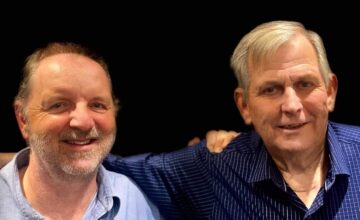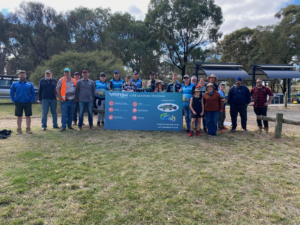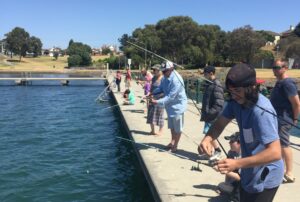October 13, 2015
by Alastair Hirst, School of Life and Environmental Science, Deakin University
Port Phillip Bay is a highly productive system, supporting one of Australia’s most prized recreational fisheries. Long-term stewardship of this resource relies upon, not only effective management of the resource, but upon the continued health and productivity of the bay’s habitats and ecosystems. Seagrass is a key habitat in the bays and estuaries of coastal Victoria and provides essential habitat for some of Victoria’s most sought-after recreational fishing species. Fisheries production for King George whiting (KGW) is closely linked to seagrass area and the majority of KGW catches come from regions adjoining major seagrass habitats in Port Phillip Bay including Corio Bay, the Geelong Arm and Swan Bay. Seagrass habitats also provide important nurseries for juvenile Australian salmon, flathead, snapper, garfish and mullet.
In recent years there has been renewed interest in restoring degraded or lost fish habitats to enhance fisheries production. Repairing where fish live is consistently rated as one of most important ways to improve recreational fishing in Victoria. However, repairing and restoring habitats requires both a longer-term perspective and commitment. The now accepted approach used to tackle such long-term issues is to bring together expertise, funding and passion from a range of key stakeholders using a model pioneered by the Port Phillip Bay Oyster Reef Restoration Program. This program is a consortium made up of government and non-government organisations, supported by the Albert Park Yachting and Angling Club.
There is an opportunity to develop a similar approach as part of a long-term seagrass restoration program in Port Phillip Bay. Recent research in Port Phillip Bay has identified factors affecting seagrass growth, reproduction and recovery that can be used to develop a restoration program. Our initial focus will be on developing techniques to help restore the loss of seagrass on the Bellarine Bank (see below). As part of this process we have been given some funding from the Recreational Fishing Licence Trust fund to consult with stakeholders and generate support and interest for a seagrass restoration program in Victoria. Over the next couple of months we will be talking with as many stakeholders as possible including local angling clubs, catchment management authorities (CMAs), non-government organisations and government. The culmination of this process will be a workshop for all stakeholders and interested parties. More importantly, this project will provide anglers with an opportunity to play a stronger role in the long-term stewardship of Port Phillip Bay and increase fishing opportunities for future generations.
Seagrasses are most closely related to land plants and share many of their attributes. As a consequence, seagrasses are typically restricted to shallow coastal waters where this is ample light to support growth, and sandy/muddy bottoms where seagrass roots can acquire sufficient nutrients without being up-rooted and washed away by waves and currents. In contrast to seaweeds, they get most of their nutrients from the sediments they grow in and have extensive root systems that help stabilise coastal sediments and reduce erosion. In Port Phillip Bay, the largest expanses of seagrass are located in shallow (<4 metres) waters protected from prevailing westerly winds (and hence waves) such as Swan Bay, Corio Bay and parts of the southern shore of the Geelong Arm and western shore of the Bellarine Peninsula (Fig. 1). By comparison, there is little seagrass found on the eastern shore of Port Phillip Bay – the coastline most exposed to prevailing winds and waves.

Figure 1: Map of seagrass habitats in Port Phillip Bay
Meadow forming seagrasses in the bay are dominated by two species, long eelgrass (Zostera nigricaulis)and short eelgrass (Zostera muelleri), with a third species, Amphibolis antartica, restricted to the more exposed bay entrance (Fig. 1). Short eelgrass tends to occur in intertidal and very shallow subtidal habitats in Port Phillip Bay, whereas long eelgrass is almost exclusively subtidal (i.e. always submerged regardless of the tides) growing to a maximum depth of 8 m within the bay. Long eelgrass meadows (Fig. 2) provide the majority of important seagrass fisheries habitat within the bay because their three-dimensional structure provides refuge from predators for juvenile fish and seagrass plants support algae (epiphytes) and invertebrates that in turn, provide food for fish.

Figure 2: Snail eye view of life in a long eelgrass (Zostera nigricaulis) seagrass meadow.
Growth and reproduction in seagrass beds occurs in three ways. Seagrass bed expansion is achieved primarily through the physical elongation of rhizomes in the sediment (similar to grass root runners) from which new seagrass shoots arise (Fig. 3). Seagrass also reproduce via seeds that result from the fertilisation of pollen and eggs produced by seagrass plants. These seeds are the source of new (genetically distinct) seedlings. The third strategy, is specific, to long eelgrass and involves the production of seagrass fragments called ‘aerial roots’ that contain both root and leaves (Fig. 4). These fragments detach and float away in currents and contribute to the establishment of new seagrass colonies in other areas. These three mechanisms are important in the growth, maintenance and recovery of seagrass beds from disturbances.

Figure 3: Seagrass shoots growing from rhizome

Figure 4: Seagrass aerial roots
Historical trends in seagrass abundance in Port Phillip Bay
Seagrass area has not always remained constant in Port Phillip Bay and has changed considerably in some regions. Researchers from Fisheries Victoria reconstructed historical trends using aerial photography and found that reductions in seagrass area over the last 70 years matched dryer periods in Victoria’s climate. For example, seagrass area was lowest following the Second World War in the 1940s and the recent millennium drought (1997–2009). This has led researchers to suggest that climatic variability may be important in controlling total seagrass area in Port Phillip Bay.
During the recent drought from 1997–2009, the greatest seagrass losses occurred on the Bellarine Bank on the southern coast of the Geelong Arm (Fig. 5). Over 90% of seagrass meadows along this coast have disappeared since 2000 and historically this region has supported high catches of KGW. The cause of these losses has been attributed to changes in sediment movement (by winds and waves) and/or changes to nutrient inputs that occurred during the drought. It is predicted that if Victoria’s climate dries there is likely to be less seagrass in the bay and greater future losses.

Figure 5: Change in seagrass area between 2000 and 2011 in south-western Port Phillip Bay.
How resilient is seagrass in Port Phillip Bay?
Concerns about the loss of seagrass and the future health of seagrass ecosystems in the bay prompted the Victorian Government to fund a four-year research project examining seagrass resilience in Port Phillip Bay. This research was undertaken by a consortium of researchers from universities and government and focussed on the role nutrients and physical processes play in influencing seagrass dynamics, how seagrasses reproduce and how they recover from disturbance. The most interesting conclusion from this research was that not all seagrass in Port Phillip Bay is alike and that seagrass beds in different parts of the bay have differing levels of resilience to a range of impacts.
The research discovered that seagrass meadows in Port Phillip Bay can be divided into ‘persistent’ and ‘ephemeral’ seagrass beds. Persistent seagrass beds are relatively stable over time, whereas ephemeral beds are much more variable and have shown major increases and declines over the last half century. Persistent beds tend to be found in locations protected from high wave exposure in areas dominated by fine, muddy sediments (e.g. Corio Bay and Swan Bay), whereas ephemeral seagrass beds are found in more exposed parts of the bay dominated by sandy sediments (e.g. Bellarine Bank and the Mornington Peninsula). Seagrass growing in ephemeral beds is often much shorter and sometimes sparser because seagrass leaves are degraded by higher wave action. Persistent seagrass beds tend to be dependent on nutrients recycled within the sediments and use nitrogen created within the sediments by nitrogen-fixing bacteria that convert nitrogen in the atmosphere into a form that can be used by seagrass. In contrast, ephemeral seagrass beds are more dependent on nutrients coming from external sources such as the catchment (river inputs) and the Western Treatment Plant (treated sewerage), and are much more vulnerable to disturbances such as storms or burial under moving sand bars. These external nutrients sources are much more variable and are likely to be heavily influenced by climatic variability, particularly the drying of Victoria’s climate and long-term reductions in rainfall.








